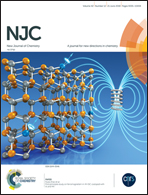Detection and selective sample clean-up of beryllium(ii) through {extractor-HOMO}(:){Be3O(OH)2}2+ ‘ion pair complexation’ amidst aluminum(iii) and uranium(vi) by employing a fluorescent resin: the resin's HOMO amount is a quantitative descriptor of BTC†
Abstract
FSG–PAN, an effective extractor, has been synthesized by chemically immobilizing PAN (1-{2-prydylazo}-2-naphthol) on silica-gel using an efficient silane-coupling-reagent, dimethyldichlorosilane. The corresponding luminescent nanomaterial has been utilized for the selective detection of Be(II) (LOD ≥ 0.75 × 10−6 mol L−1) amidst natural contaminants. The extractor selectively sorbed beryllium and aluminum (both as aqua-tri-nuclear-species, {Be3O(OH)2}2+ and {Al3(OH)3(H2O)2}6+), and uranium (as a bi-nuclear-aqua-species, {(UO2)2(OH)2(H2O)7}2+) at its highest occupied molecular orbital (HOMO) through HOMO : metal-ion-species 1 : 1 ion-pair formation. The binding stability of this interaction (0.012 eV mol−1/0.28 kcal mol−1) lies well below the classical bond energy (104 kcal mol−1) of any kind of chemical bond. The HOMO (μmol g−1) is thus an important quantitative part of the breakthrough capacity (BTC) and is expressed as BTC = {amount of HOMO (μmol g−1) × x}, where HOMO = 218 μmol g−1 and x = degree of polymerization; here, x = 3 for Be(II)/Al(III) and 2 for U(VI). Along with its excellently high BTC and enrichment factor (PF) (BTCBe(II): 645, BTCAl(III): 640, BTCU(VI): 428 μmol g−1; PFBe(II): 93.6, PFAl(III): 90.5, PFU(VI): 91.6), the appreciable durability (reusability ≥1000 cycles) and remarkable chemical inertness (BTC4M HNO3/H2SO4/HCl ≥ 95% at 4 mol L−1 acid-treatment) of the material signify its stability. By exploiting sorption-desorption selectivity, Be(II) has been sequentially separated (recovery ≥94.5 ± 2.5%) from several real and ‘synthetic multicomponent’ samples comprising its congeners.



 Please wait while we load your content...
Please wait while we load your content...